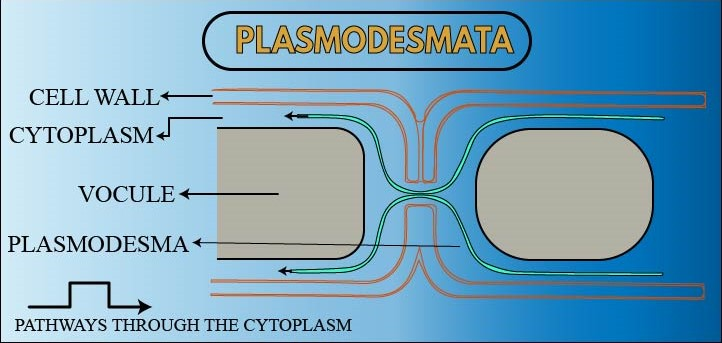
Cell to cell contact in a plant cell is maintained through
(a) Tight junctions
(b) Desmosomes
(c) Interdigitations
(d) Plasmodesmata
Answer
480.9k+ views
Hint: In plants cell to cell contact is maintained through narrow threads of cytoplasm that pass through the cell walls of adjacent cells. Such junctions are seen only in plants and algae. They were named by Strasburger.
Complete answer:
Cell to cell contact is important to maintain cytoplasmic continuity and structural integrity of an organism. This contact can be achieved using different mechanisms like desmosomes, gap junctions, etc. In plants and algae, this contact is maintained by narrow threads of cytoplasm which act as minute cytoplasmic bridges between adjacent cells. They pass through the cell walls of adjacent cells thus creating a communication.
These junctions are called plasmodesmata.
Plasmodesmata are fine cytoplasmic canals which are lined by a plasma membrane.

So, the answer is, ‘ Plasmodesmata.’
Additional Information:
Plasmodesmata form a continuum called symplast. This symplast provides a pathway for controlled passage of small particles between adjacent cells.
Molecules under a certain size called ‘size exclusion limit’, move freely through the plasmodesmal pathways by passive diffusion. This size-exclusion limit varies from plant to plant, and even among cell types within the same plant. Plasmodesmata may sometimes selectively dilate, allowing the passage of certain large molecules, such as proteins, although this process is still poorly understood.
Note: There are other types of cell connections too. Plasmodesmata are unique to plants and algal species. In animal cells, gap junctions are seen for the cell to cell contact which is a lot like the plasmodesmata. Invertebrates, these gap junctions develop when a set of six membrane proteins called connexins elongate to form a donut-like structure called a connexon. When these pores, or “doughnut holes,” of connexons are aligned a channel is formed between the cells.
Complete answer:
Cell to cell contact is important to maintain cytoplasmic continuity and structural integrity of an organism. This contact can be achieved using different mechanisms like desmosomes, gap junctions, etc. In plants and algae, this contact is maintained by narrow threads of cytoplasm which act as minute cytoplasmic bridges between adjacent cells. They pass through the cell walls of adjacent cells thus creating a communication.
These junctions are called plasmodesmata.
Plasmodesmata are fine cytoplasmic canals which are lined by a plasma membrane.

So, the answer is, ‘ Plasmodesmata.’
Additional Information:
Plasmodesmata form a continuum called symplast. This symplast provides a pathway for controlled passage of small particles between adjacent cells.
Molecules under a certain size called ‘size exclusion limit’, move freely through the plasmodesmal pathways by passive diffusion. This size-exclusion limit varies from plant to plant, and even among cell types within the same plant. Plasmodesmata may sometimes selectively dilate, allowing the passage of certain large molecules, such as proteins, although this process is still poorly understood.
Note: There are other types of cell connections too. Plasmodesmata are unique to plants and algal species. In animal cells, gap junctions are seen for the cell to cell contact which is a lot like the plasmodesmata. Invertebrates, these gap junctions develop when a set of six membrane proteins called connexins elongate to form a donut-like structure called a connexon. When these pores, or “doughnut holes,” of connexons are aligned a channel is formed between the cells.
Recently Updated Pages
Master Class 11 Accountancy: Engaging Questions & Answers for Success

Glucose when reduced with HI and red Phosphorus gives class 11 chemistry CBSE

The highest possible oxidation states of Uranium and class 11 chemistry CBSE

Find the value of x if the mode of the following data class 11 maths CBSE

Which of the following can be used in the Friedel Crafts class 11 chemistry CBSE

A sphere of mass 40 kg is attracted by a second sphere class 11 physics CBSE

Trending doubts
10 examples of friction in our daily life

One Metric ton is equal to kg A 10000 B 1000 C 100 class 11 physics CBSE

Difference Between Prokaryotic Cells and Eukaryotic Cells

State and prove Bernoullis theorem class 11 physics CBSE

What organs are located on the left side of your body class 11 biology CBSE

The combining capacity of an element is known as i class 11 chemistry CBSE




